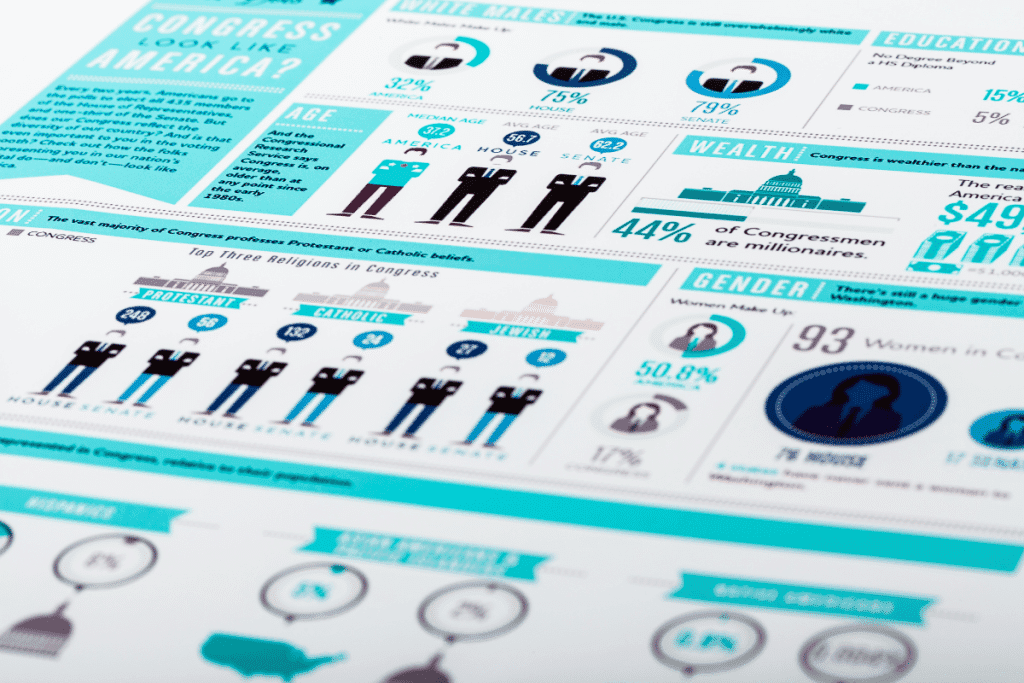Information is everywhere. However, what really matters is not just the abundance of information but how well it is communicated. This is where infographics come into play. An infographic is a tool that helps communication by simplifying complex information into digestible and engaging content.
This makes it a powerful resource, especially for professionals such as lawyers, doctors, and architects. Below, we dive into the benefits of infographics for these professionals.
How Infographics Simplify Complex Information
Infographics not only simplify complex information but also make it captivating. Professionals like lawyers, doctors, and architects can harness the potential of infographics for improved communication, education, and marketing. The success of an infographic lies in its ability to be both informative and engaging – a balance that, when achieved, can greatly help professionals in their respective fields.
Let’s look deeper into how each of these professionals can specifically use compelling infographics to distill intricate data:
A. Lawyers — Illustrate Legal Processes, Timelines, and Laws
Legal terms and proceedings can be difficult to understand for clients and the general public. An infographic can break down these concepts into easily digestible visuals and content. This promotes a better understanding of rights, obligations, timing, and procedures.
Lawyers can use infographics to:
- Depict the timeline of a case, highlighting significant events.
- Break down laws and legal jargon for clients.
- Illustrate the legal processes of courtroom proceedings.

This approach appeals not only to the clients seeking counsel but also helps increase shareability, ultimately improving SEO and brand awareness.
Infographics are excellent tools for law firm marketing as they are more likely to be shared than text-based content. They can improve website traffic, social media engagement, and client conversion rates.
B. Doctors — Simplify Medical Procedures, Diagnoses, and Treatment Plans
For doctors, infographics can help communicate complex medical conditions, procedures, and treatment options to patients. A detailed infographic can do a far better job of explaining these complexities than mere words, thereby promoting patient comprehension and adherence to treatment procedures.
Doctors can employ infographics to:
- Explain various diseases, symptoms, and risk factors in a digestible manner.
- Visually present different treatment options and their benefits.
- Illustrate medical procedures to alleviate patient anxiety.
Infographics can also be used for public health campaigns to quickly disseminate vital information to the public. They can efficiently communicate on diverse topics like vaccination schedules, chronic disease management, and health statistics.
Medical researchers can use infographics to present a summary of their research findings. This aids in increasing the accessibility and ease of understanding of the research.
By distilling complex medical information into an easy-to-understand format, infographics arm doctors with an effective communication tool while enhancing their content marketing strategy.
C. Architects — Present Design Projects and Architectural Concepts
Infographics help architects to visualize designs, building layouts, and structural plans more effectively. They can greatly aid in illustrating design concepts or architectural details to clients or construction teams.
Architectural projects encompass multiple layers of detailed information, which can lead to a cumbersome understanding. Infographics offer architects the opportunity to streamline this data by:
- Outlining the crucial details of a design project in a visually appealing way.
- Demonstrating architectural concepts, making them approachable for clients.
- Showcasing the correlation between multiple project components.
Infographics can detail project timelines, phases, and processes in a simple, easy-to-understand manner. This can further streamline communications and ensure all involved parties are on the same page. Architects can also use infographics as a creative tool to showcase their portfolio and past projects. This helps create a visual impact and memorable impressions on potential clientele.
Incorporating infographics into architectural presentations can foster client understanding and amplify the project’s visual aspect, ultimately improving search engine rankings and overall brand visibility.
Infographics have the unique ability to simplify complex information across various professions. Their visually appealing and shareable nature can massively enhance content marketing, SEO, and brand awareness. As lawyers, doctors, and architects continue to recognize and harness the benefits of using infographics, they can elevate their communication strategies and resonate with their audience more effectively.

Infographic Benefits — Enhance Retention and Engagement
The goal is clear for legal professionals, but dense legal documents often shroud the pathway. However, infographics are an excellent method of conveying complex ideas in a way that’s easier to understand. In trials, a well-designed infographic can provide a powerful aid to jury comprehension.
They can illustrate key points using types of charts, such as a timeline infographic or a comparison infographic, ensuring the most critical information gets shared effectively. This digital age tool enhances attention and memory, making every infographic you create a competitive advantage in the courtroom.
Infographics offer a clear route to enhancing patient compliance and health education in healthcare. Citing an easy-to-understand infographic example efficiently explains the benefits of medication or the disadvantages of poor lifestyle choices.
A beautifully designed infographic explaining the benefits of medication compared to the complications of untreated conditions can significantly improve patient understanding and adherence. Infographics stand as pillars of health education, making information easily digestible in the digital world.
Architects operate within intricate design dimensions. For them, a simple, engaging infographic is a game-changer. Whether it’s a statistical infographic illustrating project dimensions or a geographic infographic mapping the project’s location, the process of elaborating complex blueprints becomes simplified. Infographics help foster stakeholder engagement, ensuring that everyone, from clients to contractors, understands the project’s key features.
Incorporating infographics into your strategy offers a wide range of benefits in the world of content marketing. Not only do they simplify information and aid memory, but they also drive user engagement and are easily shareable—gaining backlinks and boosting your website’s visibility in search engine results. A great infographic is one of the best ways to tell a story that resonates with your target audience.
Going the Extra Mile — Tips for Creating Effective Infographics
Now that we understand the benefits of infographics for professionals let’s discuss some tips that can help make your infographics more effective for your specific field.
1. Know Your Target Audience
Identify your target audience and their needs – whether it is clients, patients, colleagues, or the general public. This will help you determine the type of information most relevant to them and present it in a way that resonates well.
2. Keep it Simple
An effective infographic should be easily digestible with minimal jargon. Use straightforward language, break down complex concepts into simpler terms, and utilize many visual elements to tell a story.
3. Use Of Visual Hierarchy
Employ a visual hierarchy by presenting information in a structured manner. Highlight the most important aspects of the content and use design elements to guide the viewer’s attention to those key points.
4. Maintain Accuracy
Ensure you include accurate data, statistics, and facts, preferably backed by credible sources. This will strengthen your professionalism and reinforce the trust of your target audience in the presented information.
5. Use Relevant Icons, Images & Colors
Design elements like icons, images, and colors in an infographic should be meaningful and relevant to the content. For example, adding legal-themed icons for lawyers, medical-themed icons for doctors, and architectural-theme icons for architects can aid in better content comprehension and visualization.

6. Keep It Shareable
Create easily shareable infographics, either by embedding them on a website or sharing them on social media. This will increase your reach and help garner a larger audience.
7. Include Branding
Customize the infographic with your branding elements, such as logo, company colors, and fonts. This will enhance your professional image, promote brand recall, and create a sense of consistency across your marketing materials.
Infographics are invaluable for professionals looking to communicate complex information engagingly and memorably. By understanding the benefits and implementing effective design techniques, professionals like lawyers, doctors, and architects can create infographics that enhance comprehension, foster client engagement, and build their brand’s credibility.


